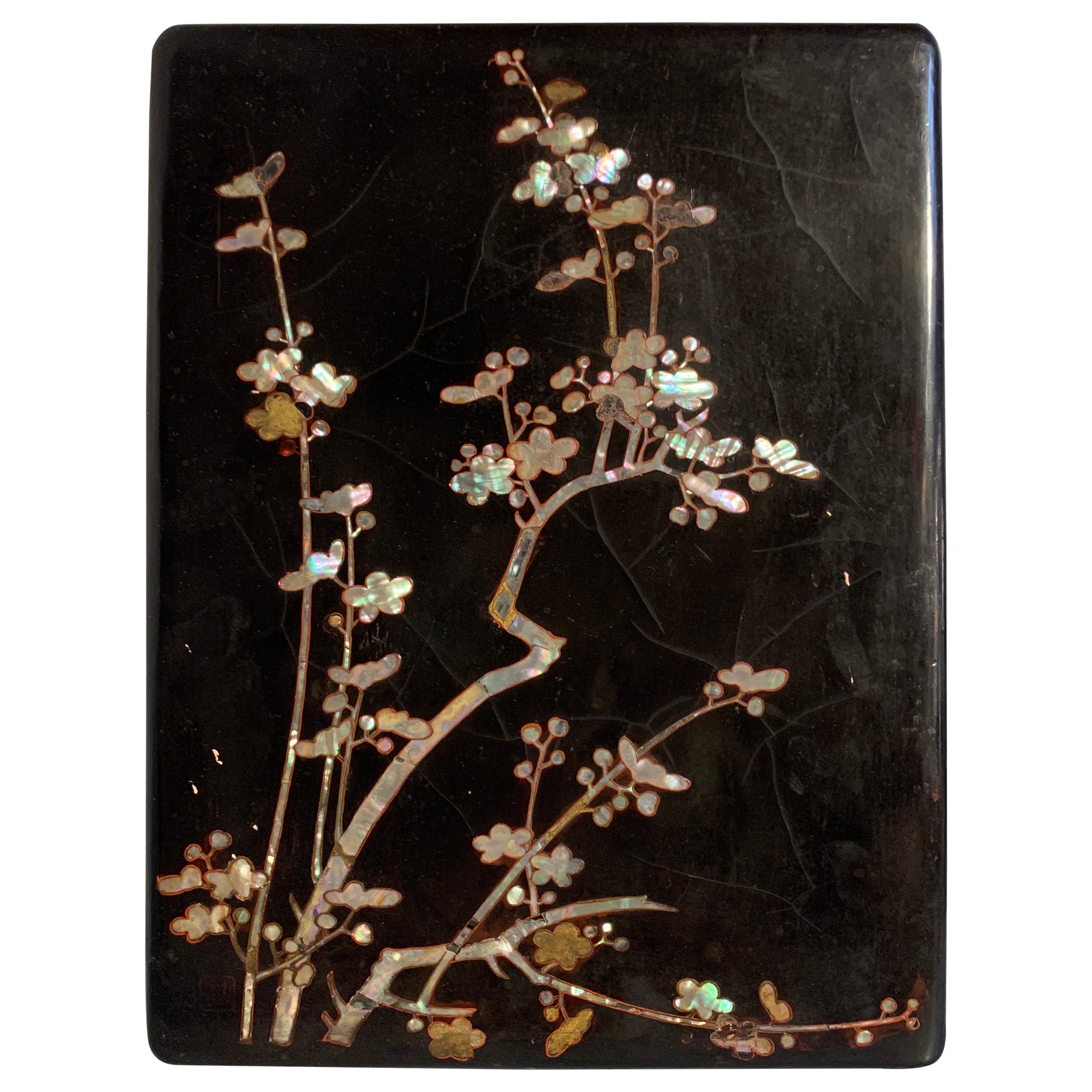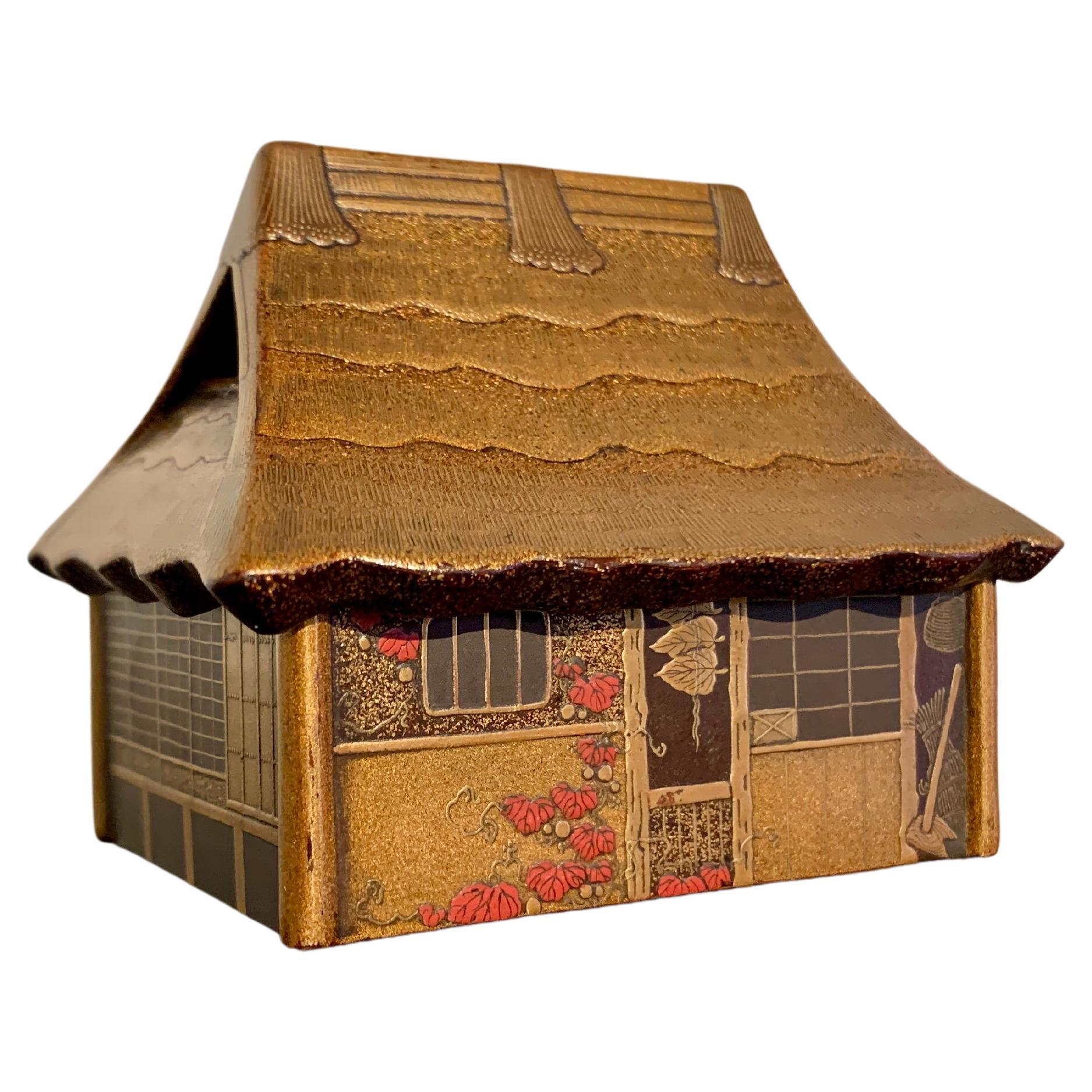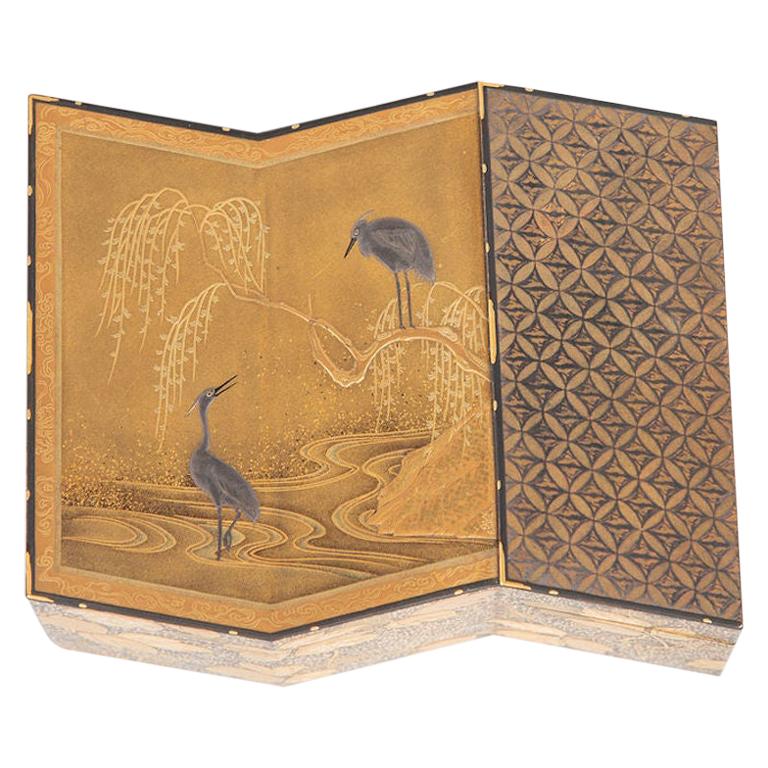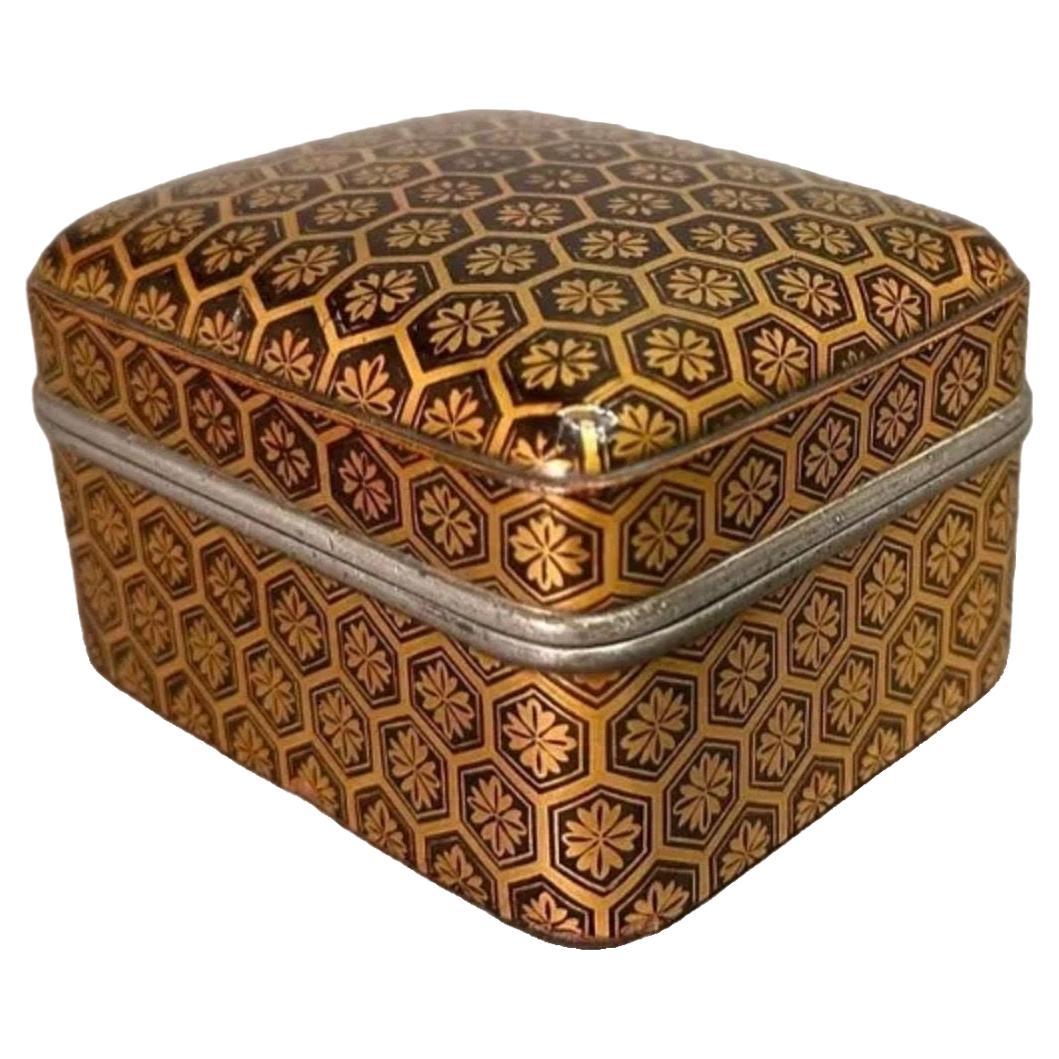Items Similar to Japanese Lacquer Incense Box, Kogo, Momoyama or Edo Period, 16th/17th Century
Want more images or videos?
Request additional images or videos from the seller
1 of 13
Japanese Lacquer Incense Box, Kogo, Momoyama or Edo Period, 16th/17th Century
About the Item
A wonderful Japanese lacquer incense box, kogo, with a design of sparrows in flight, late Momoyama or early Edo Period, circa 1600, Japan.
The small box, called a kogo, was used to store precious incense. Crafted in rich and finely worked maki-e lacquer, the exterior of the kogo decorated with a flock of plovers, chidori, in flight against golden clouds and a gold dusted sky. The interior also with maki-e chidori in flight against a nashiji ground. The rims of the kogo mounted in pewter.
Plovers, known as chidori in Japan, are considered auspicious animals, symbolizing longevity and perseverance. Their call is thought to sound like the word "chiyo", meaning ten thousand generations. Because they often fly over windy or stormy seas, they are seen as being tenacious.
With a later wooden storage box, tomobako, of Japanese cedar, sugi, with a two character inscription "kogo".
Measurements of kogo only: 2.88" x 2.63" x 1.13"
- Dimensions:Height: 2.75 in (6.99 cm)Width: 3.75 in (9.53 cm)Depth: 3.75 in (9.53 cm)
- Style:Edo (Of the Period)
- Materials and Techniques:
- Place of Origin:
- Period:Early 17th Century
- Date of Manufacture:circa 1600
- Condition:Wear consistent with age and use. Minor fading. No chips, cracks or repairs noted. Storage box of a later date.
- Seller Location:Austin, TX
- Reference Number:1stDibs: LU894727671772
About the Seller
5.0
Platinum Seller
These expertly vetted sellers are 1stDibs' most experienced sellers and are rated highest by our customers.
Established in 2001
1stDibs seller since 2010
305 sales on 1stDibs
Typical response time: 1 hour
- ShippingRetrieving quote...Ships From: Austin, TX
- Return PolicyA return for this item may be initiated within 7 days of delivery.
More From This SellerView All
- Japanese Momoyama Period Black Lacquer and Mother of Pearl Box, 16th CenturyLocated in Austin, TXA fine and unusual Japanese black lacquer and mother of pearl inlaid box, Momoyama Period, 16th century, Japan. The large box and cover featu...Category
Antique 16th Century Japanese Edo Lacquer
MaterialsAbalone, Lacquer
- Japanese Lacquer House Shaped Incense Box, Kogo, Meiji Period, JapanLocated in Austin, TXA delightful and intricately decorated lacquer box for storing incense, kogo, in the form of a traditional farm house, Meiji period (1864 - 1912), late 19th century, Japan. The kogo, or small box for storing incense, takes the whimsical form of a traditional Japanese home, minka, with the removable high, thatched roof serving as the cover for the box. The exterior of the home has been painstakingly decorated in maki-e lacquer against a matte black lacquer ground. Traditional shoji doors, bamboo blinds...Category
Antique Late 19th Century Japanese Meiji Lacquer
MaterialsLacquer
- Small Japanese Lacquer Duck Incense Box, Kogo, Meiji Period, Late 19th CenturyLocated in Austin, TXAn exquisite Japanese Meiji Period small lacquer incense box, kogo, in the form of a duck or goose, late 19th century, Japan. The delicate lacquer box, known as a kogo in Japanese, ...Category
Antique Late 19th Century Japanese Meiji Lacquer
MaterialsLacquer
- Japanese Edo Period Igarashi School Long Lacquer Box, Tanzaku-BakoLocated in Austin, TXA stunning Japanese Edo period lacquer tanzakubako, box for poem cards, late 18th-early 19th century, Edo Period, Japan. Attributed to the Igarashi School, this box is masterfully ...Category
Antique Early 19th Century Japanese Edo Lacquer
Materials24k Gold
- Japanese Lacquer Incense Burner, Koro, Edo period, mid 19th century, JapanLocated in Austin, TXAn elegant and refined Japanese lacquer koro, incense burner, in the form of a chaire, tea caddy, Edo Perio, mid 19th century, Japan. The barrel shaped koro formed as a traditional ...Category
Antique Mid-19th Century Japanese Edo Lacquer
MaterialsCopper
- Japanese Lacquer Writing Box, Suzuribako, Edo Period, 18th Century, JapanLocated in Austin, TXAn exceptionally fine and unusual Japanese lacquer writing implements box, suzuribako, in the form of a zither, koto, Edo Period, 18th century, Japan. With a modern wood storage box,...Category
Antique 18th Century Japanese Edo Lacquer
MaterialsGold, Silver, Copper
You May Also Like
- Fine Lacquer Kogo 'Incense Box'Located in Hudson, NYExquisitely detailed incense storage box in gold lacquer with silver and gold overlays of a folded screen with heron and willow design. Flowers and winding leaves on the sides.Category
Antique Late 19th Century Japanese Meiji Lacquer
MaterialsLacquer
- A Japanese Edo Period Lacquer Kogo (Incense) Box, late 17/early 18th CenturyLocated in Spencertown, NYEarly Japanese Lacquer Incense Box (Kogo) Late 17thc. Of rectangular form with soft corners, decorated with a diaper pattern in gold lacquer on a brownish black ground, with pewter r...Category
Antique 17th Century Japanese Edo Decorative Boxes
MaterialsPewter
- Japanese Lacquer Maki-E Scroll Box Fubako by Kansonsai Edo PeriodLocated in Atlanta, GAA Japanese lacquered wood fubako (a box to store document or small scroll painting) circa late 18th century of Edo period. The rectangular box features a deep lid with rounded corners and recessed mid-edge and a lower box with two bronze medallion rings and tasseled silk ties. The surface of the fubako was elaborately decorated with hiramaki-e and a low takamaki-e on a mottled Mura-nashiji background. The motifs on the lid depict branches of Japanese pine with finely rendered needles on the lower part; on the upper part, it showcases fruited persimmon branches. Two different shades of gold fundame were used to contrast the design and augmented by scattered gold kirigane to highlight some of the leaves. The design continues and cascades down to all sides of the lid as well as the walls of the box. The two bronze medallions appear original to the box and the silk ties show significant fading from the age. This Fine fubako is signed on the lower wall "Kanshosai" in Kanji with a kao mark. All the trims were finished in gold fundame and the interiors a dense nashiji in gold. Kanshosai is the mark of the distinguished lacquer artist Lizuka Toyo I who also signed his work "Toyosai". He was active in the second half of the 18th century during Edo period, employed by Hachisuka Shigeyoshi (1738-1801), daimyo of Awa on Shikoku Island. Although most survived work bearing his marks are inros, he was also known to decorated trays and other larger objects...Category
Antique Late 18th Century Japanese Edo Lacquer
MaterialsWood, Lacquer
- Fine Japanese Namban Lacquer Jewelry Casket, 17th CenturyLocated in Amsterdam, NLJapanese Namban lacquer transition-style coffer with two drawers Kyoto/Nagasaki, circa 1650 The cartouches with gilt and red decorations of leaves...Category
Antique 17th Century Japanese Edo Lacquer
MaterialsCypress
- Large Japanese Lacquer Box Early Edo Period Ex-Christie'sLocated in Atlanta, GAA large lacquer Ryoshibako (Paper box in Japanese) finely decorated with Maki-e circa 17th century early Edo period. The box is of an impressive size and was used to store paper documents. Both sides of the lid were elaborately decorated with maki-e and the edge was befitted with lead rim, an early practice before the silver rim became common later. The interior and base were finished in Nashiji. The night scene on top surface of the lid depicts flocks of chidoris flying in formation from a sea shore swaying with reeds under a full moon, using hiramaki-e in both gold and silver. Ribbons of clouds were achieved with different densities of gold powder. The underside, in contrast, shows a crescent moon in takamakie-e above the sea with ferns and reeds. Chidoris, the plovers, are symbolic in Japanese culture as "thousands of blessings" and longevity. The Namichidori, the pattern in which the chidori flies in the nami (wave) represents the eternal love and safety of couples and families. For detailed references on the historical background and the use of chidoris on lacquerware, see the reference below. This very lacquer box was featured for sale as lot 339 in Christie's London Sale Japanese Art...Category
Antique 17th Century Japanese Japonisme Lacquer
MaterialsWood, Lacquer
- Large Japanese Namban Lacquer Coffer Arqueta, 16th CenturyLocated in Amsterdam, NLA large Japanese Namban lacquer arqueta coffer for the Portuguese market Kyoto, Momoyama-period, late 16th century In Hinoki cypress lacquered in ...Category
Antique 16th Century Japanese Decorative Boxes
MaterialsMother-of-Pearl, Wood
Recently Viewed
View AllMore Ways To Browse
16th Gold
16th Century Gold
Japanese Small Box
Flights To Antique
Antique Call Box
Japanese Late Edo Period
Small Asian Box
Lacquered Japanese Box
Japanese Lacquer Box
Japanese Lacquered Boxes
Wooden Storage Box
Lacquer Box Japan
Japanese Lacquer Boxes
Japanese Lacquer Box With
Wooden Storage Boxes
Japanese Wooden Boxes
Wooden Work Box
Small Lacquer Box





